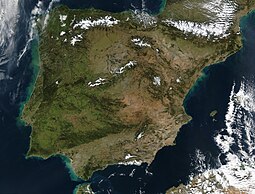Native names
| |
|---|---|
 Satellite image of the Iberian Peninsula | |
 | |
| Geography | |
| Location | Europe |
| Coordinates | 40°30′N 4°00′W / 40.500°N 4.000°W |
| Area | 583,254 km2 (225,196 sq mi) |
| Highest elevation | 3,478 m (11411 ft) |
| Highest point | Mulhacén |
| Administration | |
| Demographics | |
| Demonym | Iberian |
| Population | c. 53 million |
The Iberian Peninsula (IPA: /aɪˈbɪəriən/),[a] also known as Iberia,[b] is a peninsula in south-western Europe. Mostly separated from the rest of the European landmass by the Pyrenees, it includes the territories of Peninsular Spain[c] and Continental Portugal, comprising most of the region, as well as the tiny adjuncts of Andorra, Gibraltar, and, pursuant to the traditional definition of the Pyrenees as the peninsula's northeastern boundary, a small part of France.[1] With an area of approximately 583,254 square kilometres (225,196 sq mi),[2] and a population of roughly 53 million,[3] it is the second-largest European peninsula by area, after the Scandinavian Peninsula.
Cite error: There are <ref group=lower-alpha> tags or {{efn}} templates on this page, but the references will not show without a {{reflist|group=lower-alpha}} template or {{notelist}} template (see the help page).
- ^ a b de Juana, Eduardo; Garcia, Ernest (2015). The Birds of the Iberian Peninsula. Bloomsbury Publishing. p. 9. ISBN 978-1-4081-2480-2.
- ^ Lorenzo-Lacruz et al. 2011, p. 2582.
- ^ Triviño, María; Kujala, Heini; Araújo, Miguel B.; Cabeza, Mar (2018). "Planning for the future: identifying conservation priority areas for Iberian birds under climate change". Landscape Ecology. 33 (4): 659–673. Bibcode:2018LaEco..33..659T. doi:10.1007/s10980-018-0626-z. hdl:10138/309558. ISSN 0921-2973. S2CID 3699212.